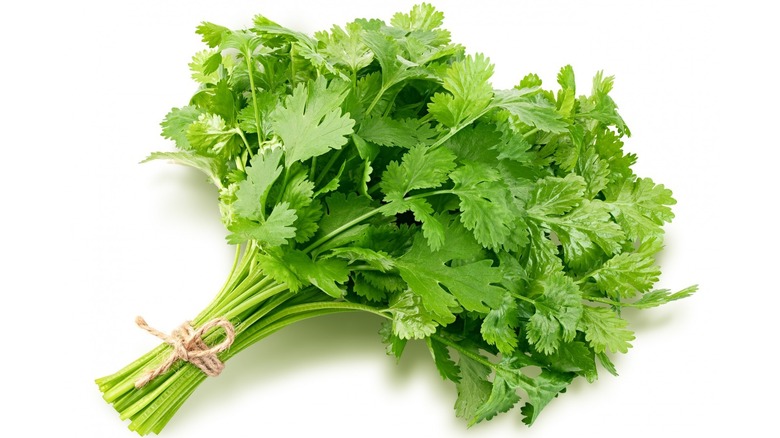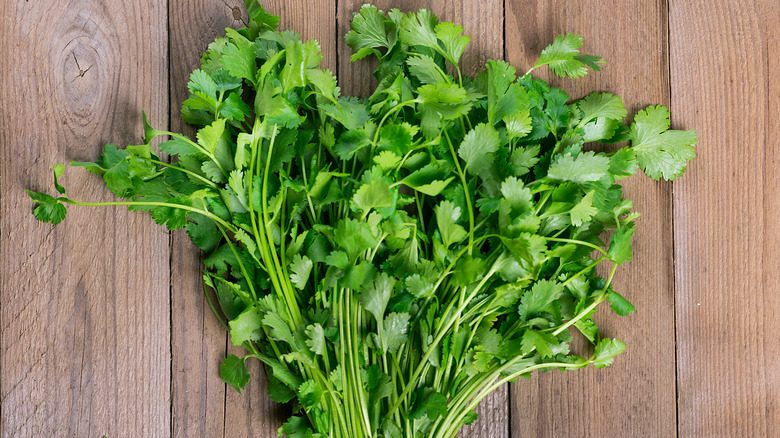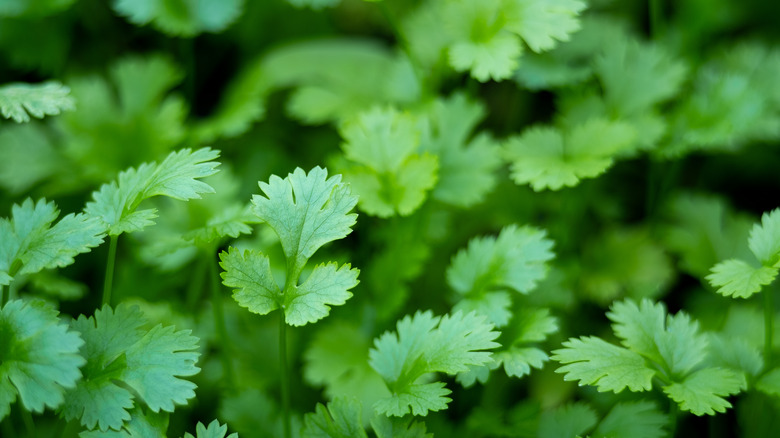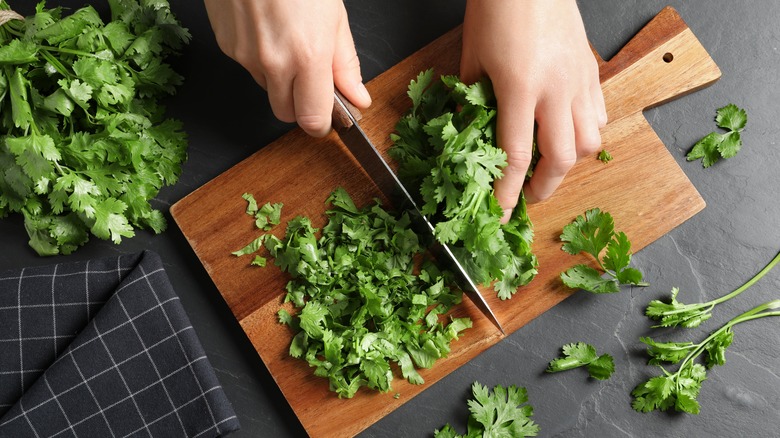How To Tell If Cilantro Has Gone Bad
Love it or hate it, cilantro has enjoyed a meteoric rise in popularity in recent years, even though for a certain percentage of the population, it can taste like soap, per Britannica. This polarizing herb is often called for in Mexican, South American, Middle Eastern, Indian, and Asian recipes, and much to the dismay of cilantro haters, it can even be found lurking in salads, soups, stews, and barbecue. Though, don't be fooled — cilantro is also commonly referred to as Chinese or Mexican parsley (the leaves look similar to the herb) and coriander.
According to Epicurious, because the flavor of cilantro is reduced when it dries, most recipes call for the fresh version. Though, unless you grow it yourself, you are usually stuck buying a large bunch of it from the store, which will require you to use it up quickly before it goes bad. One way to use up a batch of cilantro before it rots is to create a green sauce with it, similar to chimichurri. The Kitchn recommends blending cilantro, lemongrass, fresh ginger, garlic, rice vinegar, water, sambal oelek, salt, and sugar in a food processor, and then drizzle olive oil in. The best part about this recipe is that you can store it in the fridge for a week or freeze it for a month and still use it — and it tastes great on meat, rice, grilled veggies, and more.
How long will your cilantro last before it turns? Still Tasty says that it should keep for about 7 to 10 days while refrigerated; they also suggest to cut off some of the ends and then place the herb in a glass with some water and cover.
If you suspect your cilantro has gone bad, here are some foolproof indications.
Look at the cilantro's leaves and stems
The first step when assessing your cilantro to see if it is still good is to simply look at it. Pantry Tips says that a really good batch of cilantro should have a dark green shade and that the stem should be on the rigid side. If there's a yellow or brown hue, it won't be good for much longer. And, you definitely should toss it if you spot mold on the leaves. Also, when the leaves appear limp and the stem is not as tough, you are running out of time you have to still use it. At this point, you can still eat the cilantro, although it won't taste as flavorful.
To prevent cilantro from wilting prematurely, Spiceography recommends using a sharp knife when you cut it to avoid "bruising" it. Another tip to prolonging the life of the herb is to make sure everything is dry and patted down — both the knife and the plant; this will make sure it doesn't stick to the blade while chopping it. Doing so will also help to expedite the process and cut down on any wasted material.
Another great idea from the Food Network is to chop up more cilantro than you need while you are prepping it for a dish and then they recommend to add some with ice or water to ice cube trays and freeze. You'll then have the pre-made cubes on hand and can easily add to any recipe when you need them.
Smell the cilantro
To some people, no matter what, the odor of cilantro is never pleasant. According to NPR, studies have been done that link a distaste for the herb with "specific genes involved in taste and smell." In fact, The New York Times reports that Julia Child disliked cilantro so much that, during an interview with Larry King, she said, "I would pick it out if I saw it and throw it on the floor."
There is some evidence, however, that you can overcome your distaste for cilantro. According to Britannica, this can happen with "repeated exposure to the herb, especially if it is crushed rather than served whole." Whether this is true or not has yet to be determined. Yet, cilantro haters are a vocal and stubborn group and may not be open to embracing the herb — if that's you, you might want to move on from this next step.
For those who don't suffer from "cilantrophobia," however, take a sniff to see if it's still usable. If it's slightly earthy like it normally would be, you're all good. But, if it seems "off" or even smells sour or pungent, toss it, says Still Tasty. As well, Pantry Tips adds, fresh and usable cilantro usually doesn't have much of a traceable scent at all, so if you smell anything, you probably want to discard it.
Taste the cilantro
Fresh cilantro usually has a lemony and somewhat peppery taste, although (as discussed), to some people it has a soapy flavor. Shape explains that this is because there are natural compounds found in the leaves that are also often added to soaps for a scent — hence where the comparisons for some people come in. These folks also may carry a certain variation of a gene, which makes them sensitive to these compounds, which are called aldehydes.
Unlike most food that has gone bad and has a strong rotten taste, cilantro loses its flavor when its past its prime, which is great news for cilantro haters (via Pantry Tips) — and also means you'll know when cilantro is no longer good because it won't be as flavorful. Cooking cilantro also adds to the loss of its tastiness, which is why most recipes call for an additional amount at the end of the cooking process or to use it as a garnish.
While the leaves are the most commonly used part of the herb and are what makes cilantro attractive as a garnish, the stems can be just as tasty. You can chop them finely or put them in a food processor and use them in the same pesto sauces and guacamole as you would the leaves (via Spiceology).



